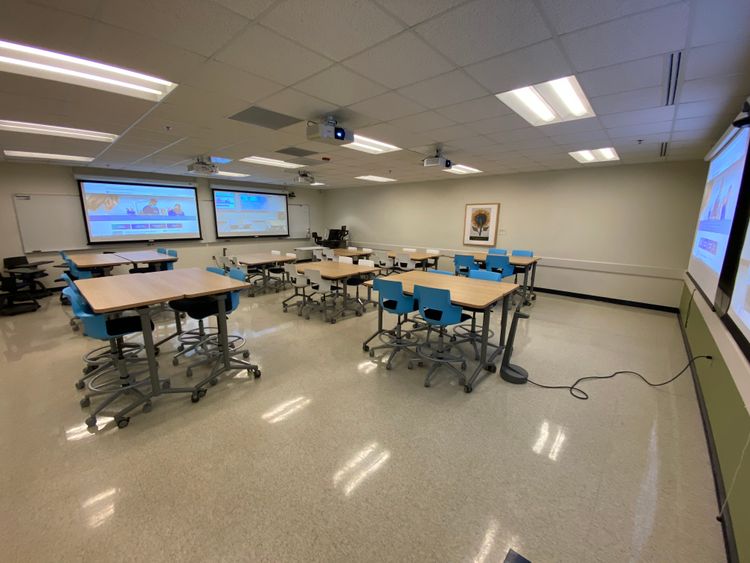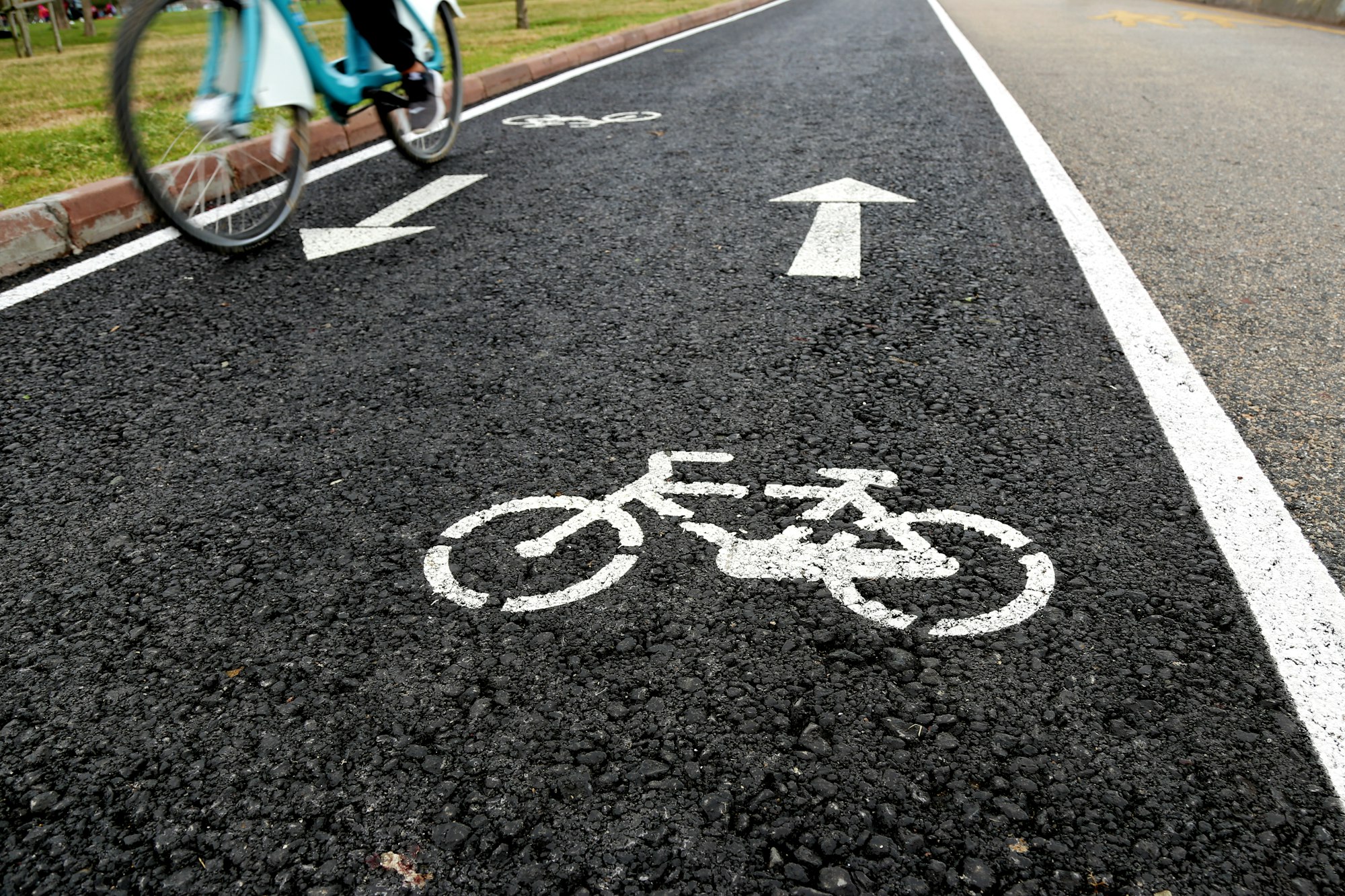Why we should embrace active learning

Two weeks ago I had the pleasure of giving the keynote address at Schoolcraft College, a thriving two-year institution in suburban Detroit, for their "Welcome Back" event. This is a gathering they hold at the start of each semester for faculty and staff, to reassemble as a community for the new term and learn things that will help them and their students. It was not only a welcoming back for them but also for me: It was the first in-person speaking event I'd done since March 2020, just days before the world shut down.
My talk was titled "Three good reasons and three bad reasons to embrace active learning".
Here's the "handout", a Google Doc with links to everything.
This had been planned as an in-person event months ago, before the rise of the Omicron variant of Covid-19. In the days leading up to the event, it looked like we might have to pivot it to an online presentation, but in the end we did it in-person but with a livestream for those who didn't want to attend physically. I think it ended up being about a 2:1 ratio of remote versus in-person participants.
The main point of this talk is the same as many, maybe most, of my talks:
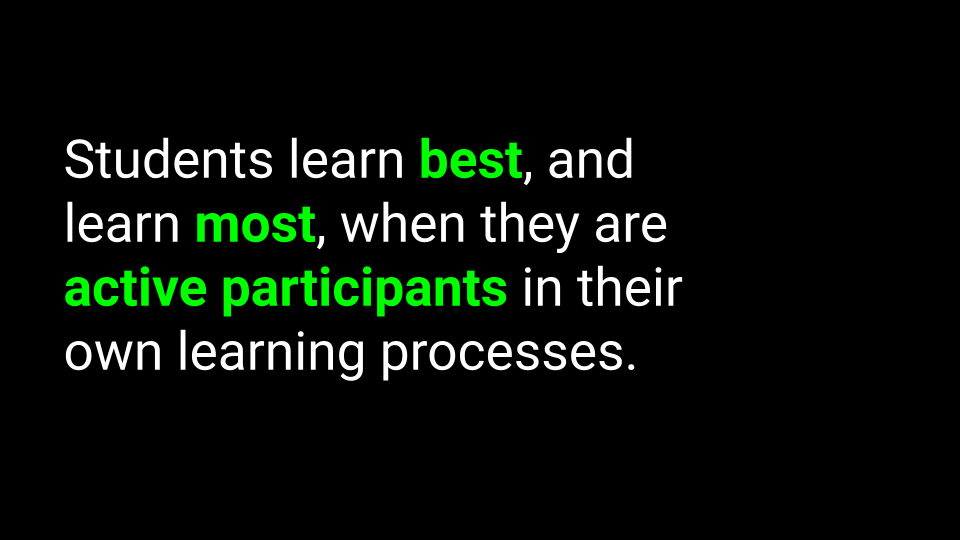
The good reasons
In the talk, as the title says, I gave three good reasons for embracing active learning:
Science. There seems to be a widespread belief that active learning is an amorphous concept with no real definition, perhaps even undefineable, and no research to support its use. In fact, this hasn't been the case since the 1990's, when Bonwell and Eison wrote a manifesto about active learning that gives a definition (albeit not super-technical) and unpacks it over many pages:
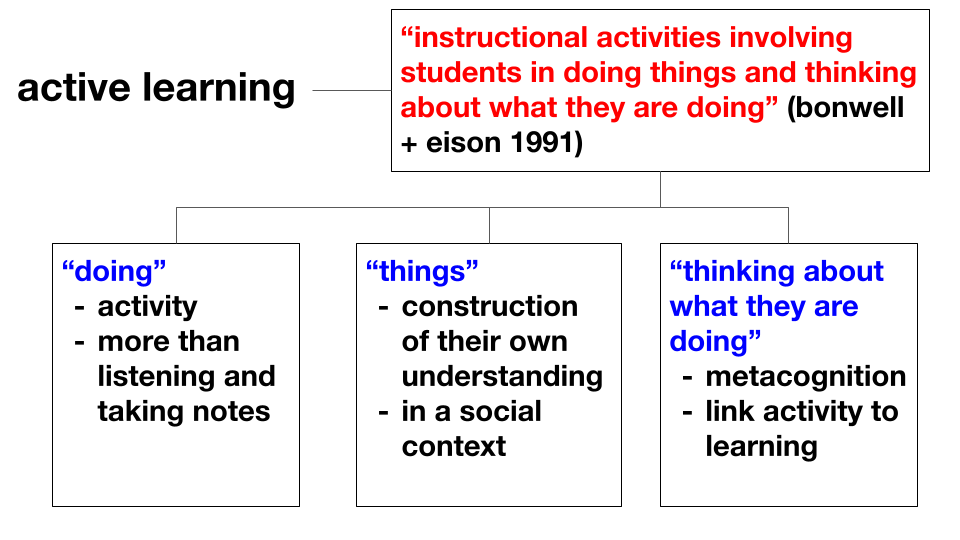
And based on this definition, we have just in the last ten years seen a mountain of evidence pointing to the benefits of active engagement versus more passive pedagogies based on lecture. Many people are still not aware this research exists! I told the audience, and still do tell everyone I meet, that if nothing else, they should go home this evening and read the Freeman 2014 study from the Proceedings of the National Academy of Sciences --- just 8 pages long, and if it doesn't shake your worldview then you might want to check your pulse.
I've used the above slide before in past talks. For this one, I wanted to update my data points, so I researched more recent attempts at defining active learning and found a newer definition from Doug Lombardi's research group. Here is their definition:
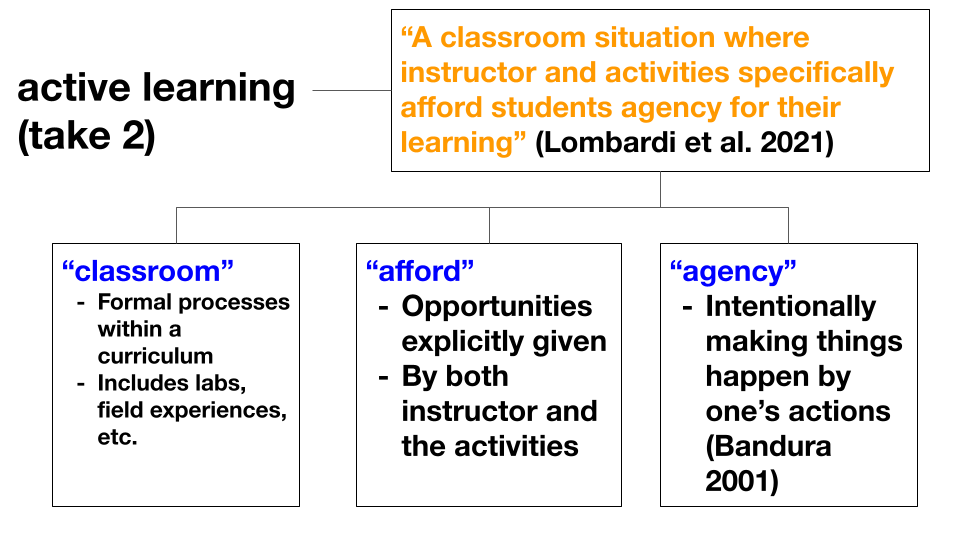
Lombardi also talks about what they call the construction-of-understanding ecosystem, which is more of a framework for student learning than a straight definition:
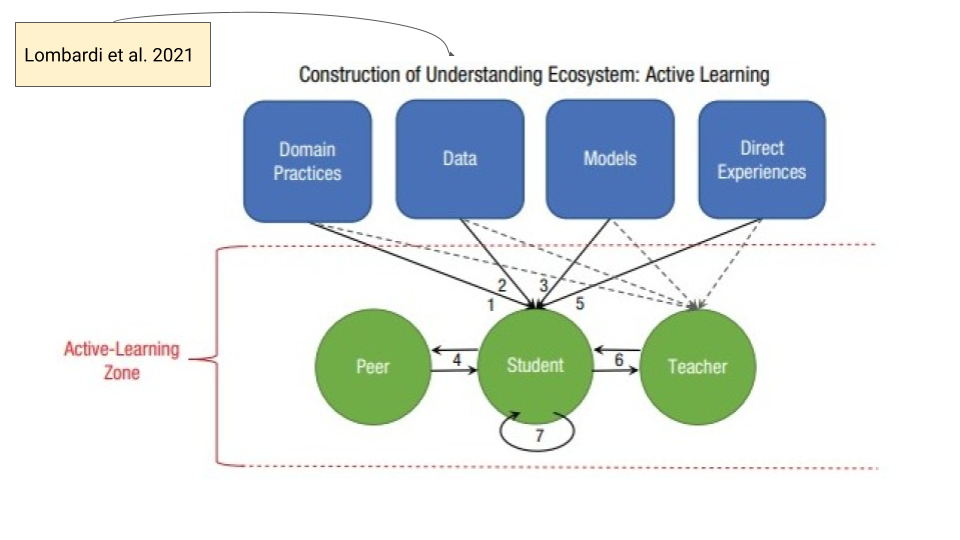
I really like this "ecosystem" conception of active learning and will have more to say about it in another post. For now, it's enough to note that it provides a highly useful theoretical framework for doing and implementing the growing body of research supporting active learning. Active learning is way more than just "not lecture".
Equity. Some of that research I mentioned is pointed specifically at equity issues. For example this 2006 paper describes how peer instruction eliminated the gender gap on concept inventory performance in university physics classes. And this one from 2014 shows that active learning interventions are related to an improvement in exam performance for all students, but Black and first-generation students are helped disproportionately.
Every study has some kind of validity issue and these are no different; you can read them for yourself and see. But, this shouldn't keep us from wondering whether the equity issues we face in higher education are somehow related to --- and can possibly be helped by --- the pedagogies we choose. What we don't want (I told the audience) is a situation where we have a body of faculty on the one hand and a DEI office on the other, with faculty thinking "Equity is the DEI office's problem, not mine" and the DEI office thinking "Pedagogy is the faculty's problem; not mine". The research is telling us that they are connected; DEI initiatives that don't take pedagogy into account and teaching that doesn't take equity into account are equally impoverished.
Or, as I put it to the audience:
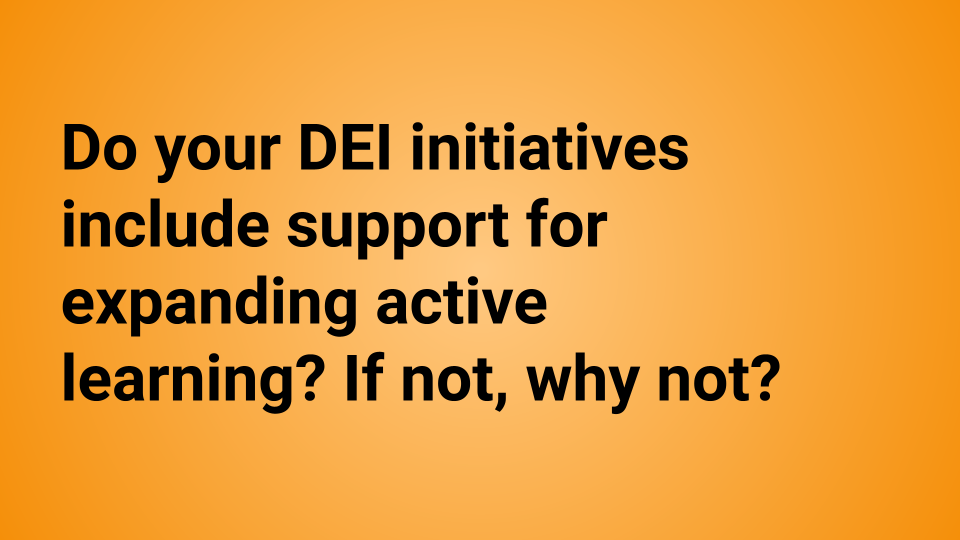
Integrity. Given how much we know about the benefits of active learning for students, particularly in terms of equity --- and given that most colleges' official documentation goes on endlessly about how important equity is --- how come lecture is still, by a wide margin, the most commonly used teaching method on most college campuses?
Answer: I have no idea. But if we want to work with even a modicum of integrity as institutions, the pedagogy we use has to be a concrete representation of what we say our institutional missions are. At the very least, the pedagogy shouldn't contradict the mission. To that end, at Schoolcraft I went out on a limb and studied their institutional value statement, and highlighted every point of it where active learning in the classroom would support what they say is important to them:
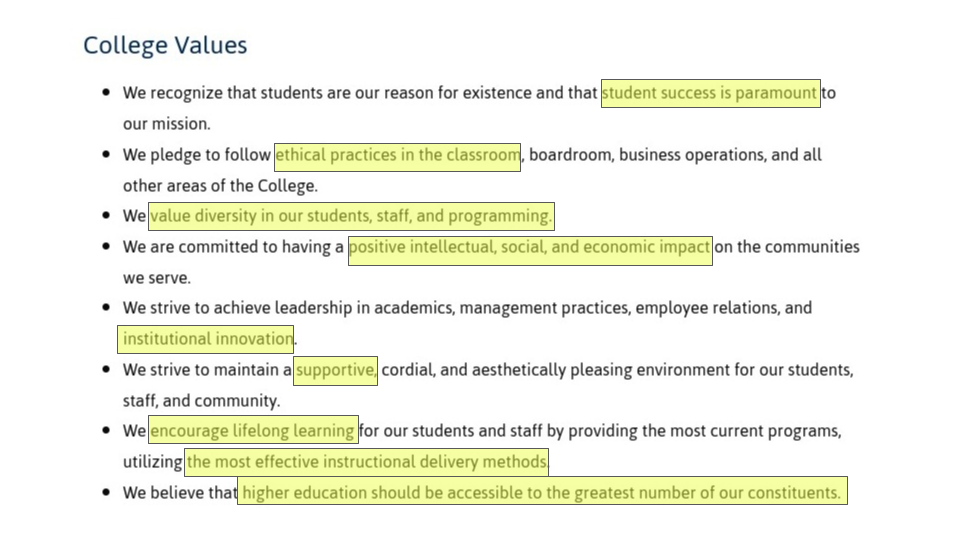
I just asked the audience, particularly the administrators present, Is what's taking place in your classrooms representative of what you say that you value? Or put another way (which I did not say out loud, because even I have limits) Are you actually serious about these values, or are they just words from a focus group posted to a website?
In the end, integrity matters, and your college just isn't viable if you say you value something and know that certain teaching methods enact and further those values, and then choose to teach in some contradictory way. It would be better to just keep teaching the way you do and just be honest in the value statements -- for example We encourage lifelong learning, but we value ease of instructional delivery more.
The bad reasons
Active learning is good, but you can adopt it for at least three wrong reasons:
- You believe students will automatically love it. Anybody who has done active learning with real students knows this is not the case. This study --- which has the most suggestive title ever, "Measuring actual learning versus feeling of learning in response to being actively engaged in the classroom" --- goes into graphic detail about how students feel they learn more in lecture even when they know they've learned more in active learning. Read it, although you probably don't need to in order to get the point.
- Active learning involves technology and students love technology. First of all active learning does not necessarily involve technology (although the pandemic has changed this to a degree). But mainly, the concept of the digital native is still a misconception under which many instructors still labor. People who go around giving keynotes and PD sessions espousing digital native-ness aren't helping. Students do not automatically love technology; in fact two years into remote instruction, students probably like it less than ever. So if you're counting on flashy tech tools to carry the day instead of the consistent communication and trust-building that active learning and all other instructional innovations require, you're in for a shock.
- Not having a reason. The worst reason to do active learning, or anything else, is when you really don't have a reason but are just doing it to be doing it, or because you think that's what other people want. I believe in the Five Levels of Why approach, where you ask Why? five times in a row to iterate through the reasons for doing something. If you get to the end of the five why's and have not reached a reason for doing the thing that is not B.S., that resonates with you, and which you can return to repeatedly when things go south, then you probably shouldn't be doing that thing right now.
Further thoughts
Putting this talk together, I did a lot of reflection on how things have changed since that last in-person talk in March 2020.
That talk was part of a week-long visit to Universidade de São Paolo (USP) where I was working with the engineering, physics, and math faculty on restructuring their class designs around flipped learning, in order to inject active learning in a major way into how they taught. The USP faculty knew change was happening. The Brazilian government was instituting an aggressive program of affirmative action bringing millions of rural, indigenous, and low-income Brazilians to federal universities for the first time, and the old-school lecture techniques --- which worked fine for their historical audience of economically advantaged, urban young people --- was failing. The growth of the city of Sao Paolo, already a massive city 1.3 times the population of New York, was bringing urban issues of housing and transportation to bear on their students; one faculty member told me his attendance rate was near 10% for lectures because students couldn't afford the commute to campus. And most faculty I talked to had the all-too-familiar concerns that the system of "biweekly lectures + midterm + final" was not producing the problem solving and collaboration skills that Brazil needed from its engineers. Faculty in Brazil don't need to be convinced about the need for change.
But little did we know at the time just how much change was still coming, just weeks away. The pandemic hit Brazil particularly hard, and it accelerated the perceived need for pedagogical change in the university like pouring gasoline on a fire. If anything, it's even clearer now that active learning --- while not a panacea for all educational problems, Brazilian or otherwise --- is the direction in which higher education should, and must move.
Detroit is a lot like Sao Paolo in many ways: Big, diverse, bustling, culturally rich. The Detroit area has a number of two-year institutions that have a special role to play in the demographics and economy of that region. Schoolcraft was the third such institution I've worked with, and I've always enjoyed it because, as I told the audience, two-year institutions in Detroit are as real as it gets. They are the exact opposite of the ivory tower. You have everyday people from all stations and situations of life, all career trajectories, all races and many different parts of the world converging on the college for one purpose: To learn and get better, and there's very little privilege at play, and zero tolerance for the B.S. of "academe" among those folks.
So all of these injunctions to embrace active learning, and to do it for the right reasons, have a home at these institutions --- and at my own, and everywhere else. Active learning is the pedagogy of real life. It doesn't matter whether you're an 18-year old from the hinterlands of central Brazil or a 30-something manufacturing worker from Livonia looking to make a career move --- the pandemic has taught us that while life and the world change, learning is still what makes us human, and all of our learning experiences that actually matter are done when we are active participants in constructing the meaning of what's being taught. For those and many other reasons, that's the direction we should be moving.

